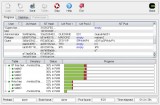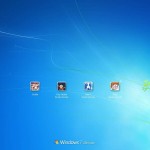About BOOT.INI File in Windows XP
Windows XP use a configuration file called BOOT.INI to control how the operating system is booted and any startup options. By modifying the startup switches you can manage the boot process including booting Windows in Safe mode, creating a log file, or disabling the splash screen. BOOT.INI file found on the root partition of your hard drive (normally C:\). You may need to enable “show hidden hidden files” Options and and uncheck “hide protected operating system files” in windows explorer to view this file.
To modify BOOT.INI file, Right-click on the file, then select open with, in notepad or wordpad. Other methode to open the file, by right click mycomputer – properties – advanced tab – startup and recovery setting – edit. Before modifying the file you may like to make a backup of the file at this point to allow you to restore if you experience problems. after opening the file under the [operating systems] section you will find a list of all the installed operating systems. For example:
multi(0)disk(0)rdisk(0)partition(1)\WINDOWS=”Microsoft Windows XP Home Edition” /fastdetect
To enable or disable startup options simply change or add any of the switches listed below to the default command-line. For example you could add “/SOS” to the command-line above to display the splash screen and view the drivers being loaded.
- /BASEVIDEO – The computer starts up using the standard VGA video driver. Use this if you have installed a graphics driver that is not working.
- /BAUDRATE – Specifies the baud rate to be used for debugging. If you do not set the baud rate, the default baud rate is 9600 if a modem is attached, and 19200 for a null-modem cable.
- /BOOTLOG – Makes write a log of the boot to the file %SystemRoot%\NTBTLOG.TXT
- /CRASHDEBUG – The debugger is loaded when you start Windows NT, but remains inactive unless a Kernel error occurs. This mode is useful if you are experiencing random, unpredictable Kernel errors.
- /DEBUG – The debugger is loaded when you start Windows NT, and can be activated at any time by a host debugger connected to the computer. This is the mode to use when you are debugging problems that are regularly reproducible.
- /DEBUGPORT=comx – Specifies the com port to use for debugging, where x is the communications port that you want to use.
- /FASTDETECT – Specifying FASTDETECT causes NTDETECT to skip parallel and serial device enumeration for a boot into Win XP.
- /HAL=<hal> – Allows you to override the HAL used, for example using a checked version.
- /INTAFFINITY – Sets the multiprocessor HAL (HALMPS.DLL) to set interrupt affinities such that only the highest numbered processor in an SMP will receive interrupts. Without the switch the HAL defaults to its normal behavior of letting all processors receive interrupts.
- /KERNEL=<kernel> – Same as above but for the kernel.
- /MAXMEM:n – Specifies the maximum amount of RAM that Windows can use. This switch is useful if you suspect a memory chip is bad.
- /NODEBUG – No debugging information is being used.
- /NOGUIBOOT – When this option is specified the VGA video driver responsible for presenting bit mapped graphics during Windows boot process is not initialized. The driver is used to display boot progress information, as well as to print the Blue Screen crash screen, so disabling it will disable Windows XP ability to do those things as well.
- /NOSERIALMICE=[COMx | COMx,y,z…] – Disables serial mouse detection of the specified COM port(s). Use this switch if you have a component other than a mouse attached to a serial port during the startup sequence. If you use /NOSERIALMICE without specifying a COM port, serial mouse detection is disabled on all COM ports.
- /NUMPROC=n – Only enables the first n processors on a multiple processor system.
- /ONECPU – Only use the first CPU in a multiple processor system.
- /PCILOCK – Stops Windows NT from dynamically assigning IO/IRQ resources to PCI devices and leaves the devices configured by the BIOS.
- /SAFEBOOT – This is an automatic switch which NTLDR should complete for you when you use the F8 menu to perform a safe boot. Following the colon in the option you must specify one of three additional switches: MINIMAL, NETWORK, or DSREPAIR. The MINIMAL and NETWORK flags correspond to safe boot with no network and safe boot with network support. The safe boot is a boot where Windows XP only loads drivers and services that are specified by name or group in the Minimal or Network Registry keys under HKLM\System\CurrentControlSet\Control\SafeBoot. The DSREPAIR (Directory Services Repair) switch causes NT to boot into a mode where it restores the Active Directory from a backup medium you present. An additional option that you can append is “(ALTERNATESHELL)”. This tells NT to use the program specified by HKLM\System\CurrentControlSet\SafeBoot\AlternateShell as the graphical shell, rather than to use the default which is Explorer.
- /SOS – Displays the driver names while they are being loaded. Use this switch if Windows NT won’t start up and you think a driver is missing. This option is configured by default on the [VGA] option on the boot menu.
- /YEAR= – Specifying this value causes Windows XP core time function to ignore the year that the computer’s real-time clock reports and instead use the one indicated. Thus, the year used in the switch affects every piece of software on the system. Example: /YEAR=2005.





One Response to “About BOOT.INI File in Windows XP”
These things can also be enabled or disabled by going to Start> Run> msconfig> boot.ini tab. Of course, the method stated above is very descriptive and gives us an idea as what a particular setting does.